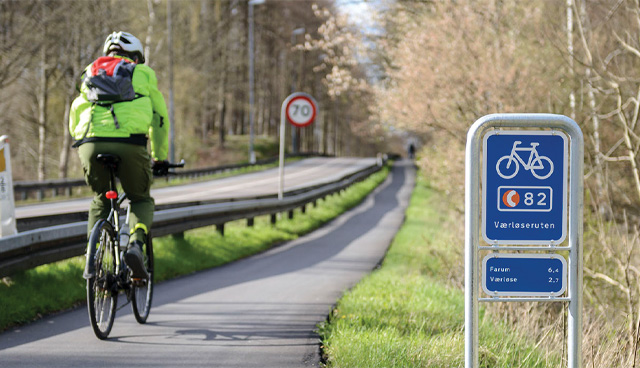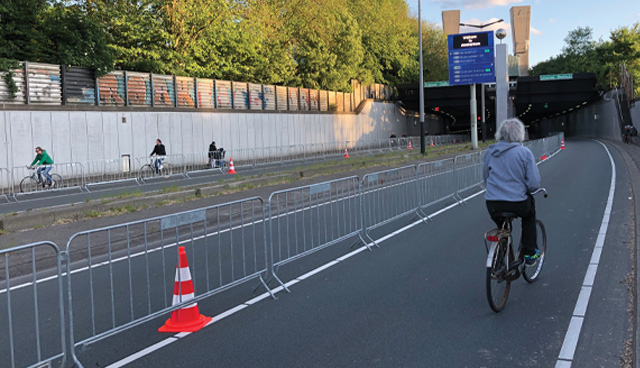Cycling superhighways: European exemplars

Cycle networks “as good as those in the Netherlands and Denmark” are needed if Ireland is to tackle its overreliance on the car, the Oireachtas Climate Action Committee has been told. eolas examines the infrastructure of the two countries that have become European exemplars of active travel.
“We need to design cycle networks as good as those in The Netherlands and Denmark,” Lynn Sloman, Director of Transport for Quality of Life and specialist in environmental and sustainable transport consulting, told the Oireachtas Climate Action Committee. “Growth in popularity of e-bikes means longer cycle trips are feasible, and so cycle superhighways radiating out from towns for 15 kilometres or more should be part of a decarbonisation strategy.”
Cycling superhighways, also known as bike freeways, fast cycle routes, or bicycle highways, are bicycle paths meant for long-distance travel. Cycle superhighways feature an absence of single-level intersections with motorised traffic, road surfaces more suitable for cycling, typically asphalt or concrete, and no traffic lights. The routes are designed to offer an alternative for private travel to the car. They are typically separate from main roads and often follow the route of rail tracks.
The Oireachtas’s Climate Action Committee has recommended a 51 per cent emissions reduction target for transport by 2030 be adopted by the Government. Sloman’s recommendations were given as part of a series of hearings staged by the committee on how this goal can be achieved in a sector that accounts for 20 per cent of Ireland’s carbon emissions.
The kind of change needed to create more opportunities for active travel and to have fewer cars on the road is politically difficult, Sloman admitted, but is a change that “creates more winners than losers, and particularly benefits the young, older people, those on a low income and women”. “Places that have implemented a road user charge find that once residents see how it improves their town or city, there is net support,” she said.
The Netherlands
The Netherlands is one such place that has implemented a network of cycling superhighways that is often cited as an international example of the potential of these infrastructural projects. In the Netherlands, the following people can make use of their cycling superhighways:
- cyclists: ordinary cyclists, recumbents, cargo bikes, velomobiles, pedelecs;
- riders of motorised bicycles, with a maximum speed of 25 km/hour;
- in some locations, mopeds are permitted with a maximum speed of 40 km/h;
- pedestrians in the case of missing footpaths and pavement;
- Segway riders; and
- drivers of a disabled vehicle, with a maximum speed of 30km/h applied.
The Dutch Ministry of Transport, Public Works and Water Management provides guidelines for the development of cycling superhighways, which it describes as “a long cycle path without crossings, on which cyclists can travel long distances”. The Netherlands has almost 35,000km of cycling paths that are physically separate from motor traffic, approximately a quarter of the country’s 140,000km cycling path network.

“Places that have implemented a road user charge find that once residents see how it improves their town or city, there is net support.”
In areas with these dedicated cycling paths, use of them is obligatory for cyclists. Mopeds are also obliged to use the paths, with a blue license plate, when the maximum speed is 25km/h; in the case of maximum speed being 45km/h, with yellow license plates, mopeds are only allowed to use the cycle paths if that is indicated, which typically happens in more built-up areas. Bi-directional bike paths on one side of the road are common in towns as well as in the countryside, with the paths divided into two lanes by a dashed line and sometimes existing on both sides of the road in order to limit the number of times cyclists are forced to cross the road. Some routes feature tunnels lit with smart LEDs that connect with and respond to passing cyclists’ phones, with more frequent riders unlocking a greater number of pastel lighting choices.
Denmark
Denmark has an estimated 7,000km of segregated dedicated bicycle paths and lanes, with its four biggest cities alone accounting for more than 1,350km: 609km in Aalborg, 510km in Odense, 450km in Aarhus, and 412km in Copenhagen. The country also has a network of national cycle routes featuring 11 routes in total.
A 2019 study found that, on average, the appearance of safe lanes in the superhighways in Copenhagen brought with them a 23 per cent increase in cyclists versus data stretching back to 2010. A survey of those using the routes found that 14 per cent of the new cyclists used to commute by car and that safe lanes had eliminated user bias, with 52 per cent of cyclists being women.
58 per cent of the Copenhagen population have a journey of less than 10km to make, and as such, cycling has proved popular in the Danish capital. 35 per cent now commute by bike, up from 29 per cent since 2010, although bicycle traffic levels have decreased by 5 per cent at national level.
It is estimated that every 11km cycle of the Allerød route in Copenhagen saves up to 2.8kg of CO2 over the same journey by car. The proliferation of cycle routes is also said to have had positive health effects in Denmark, with 333 fewer sick days per day reported amongst the population. This is based on the calculation that for every 1,200km biked, one less sick day is reported. Factoring in the 11km of the Allerød cycle route, would burn on average 209 calories and electric bike users 124 calories.
Just 17km of cycling superhighway infrastructure existed in the region in 2012. This had risen to 38km by 2013 and 167km by 2019. 248km of superhighway is forecast to have been laid by 2022, with 680km due for 2030 over 750km by 2045.
Speeds on the superhighways average at 19km/h, with 400,000km covered per day and the number of cyclists counted on a weekday peaking at 29,000. 86 per cent make use of the network more than once weekly.





